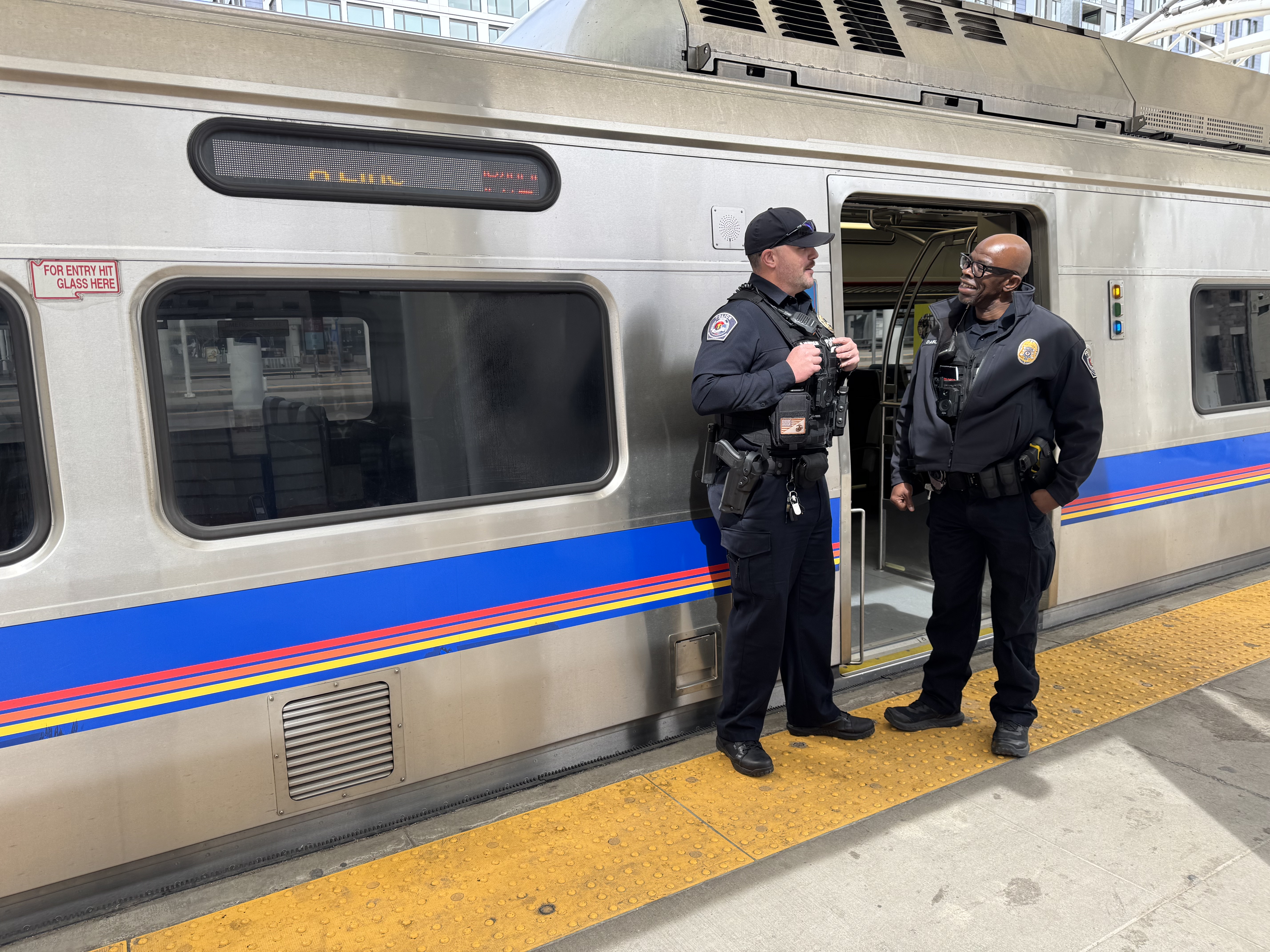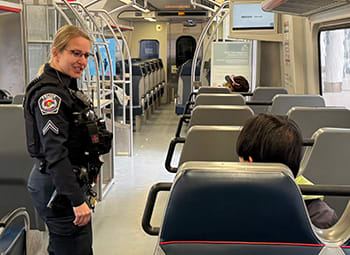
Partners in Safety
Overview
At the Regional Transportation District, the personal safety and security of our customers and employees is a top priority. Our systemwide safety plan encompasses topics related to RTD's operations, customers, motorists, cyclists, and pedestrians. As a member of the Denver metro area community, RTD is constantly working to create a safer and more secure transit environment.

Personal Safety and Security
Whether you’re waiting to connect or travel to your final destination, RTD is focused on providing a Welcoming Transit Environment during every step of your journey. We’re doubling down on our efforts to enhance your personal safety and security.
RTD continues to add police officers, increase patrols across the system, and upgrade cameras and lighting at facilities to improve safety and surveillance. Our recently enhanced and real-time reporting tools, such as live look-in cameras on vehicles and the Transit Watch smartphone app, make it easier for RTD to quickly respond to any incidents.
Learn MoreOperational Safety
With trains and buses always on the move, it is important to educate customers and the public about the importance of safety on and around our transit system. RTD launched the Partners in Safety program in 2010, which is a collaborative effort between RTD employees, passengers and the public to create awareness of safety issues and take actions to promote a safer environment around our buses, trains, tracks and crossings.
Overview
Bike Safety
- Always wear a properly fitted helmet and securely fasten the chinstrap.
- Ride in the same direction as traffic and follow traffic signs and signals.
- Never user electronics while riding--they are distracting.
- Watch for opening car doors and other hazards.
- Wear bright-colored clothing.
Bus Safety
- Stand a safe distance from the curb and stay clear of the bus until it has stopped.
- Never chase or hit a moving bus.
- Hold on at all times as sudden stops may occur.
- Remain seated while approaching your bus stop.
- Don't speak loudly or make loud noises that could distract the driver.
Pedestrian Safety
- Eyes up, phone down. Look up from your phone and pay attention--don't be distracted!
- Wear bright colors or reflective clothing if you are walking near traffic at night.
- Make eye contact with drivers when crossing busy streets.
- Cross at intersections or crosswalks, not in the middle of the road or between parked cars.
Train Safety
Train Ride Safety
- Mind the gap. Watch your step while getting on and off the train.
- Train doors close automatically; stand clear and listen for the warning chime.
- Take time to review the Emergency Procedure signs posted in each train car.
- In the event of an emergency, notify the train operator using the emergency intercom at either end of the train.
Train Track Safety
- Cross only at designated crossings and follow traffic rules.
- Never walk or bike along the tracks; it is illegal and dangerous.
- Look both ways before crossing the tracks--trains can travel from either direction at any time.
- Remove your headphones when you are around trains or near the tracks.
Platform Safety
- Stay behind the yellow line at all times.
- Never sit on the platform edge or touch the outside of a train.
- If you drop something onto the trackway, do not attempt to retrieve it.
- Walk--do not run--on the platform. If you miss a train, wait for the next one.
Winter Weather Transit Safety
Riding the Bus
- Take an earlier trip. Buses move only as quickly as traffic allows.
- Stand back. Buses may slide on snow as they approach the curb.
- Make yourself visible to an approaching bus especially on dark winter mornings.
- Bus steps become slippery from snow. Kick the snow from your shoes before stepping on the bus. Use the handrails and take your time.
- Dress warmly and put on an extra layer. Even a short wait at your stop can be dangerous if you're not dressed for the weather.
- Remember, your driver is doing his or her best to ensure you arrive at your destination despite bad road conditions.
Riding the Train
- Although winter weather shouldn't slow travel times for trains, consider taking an earlier trip to ensure timely arrival.
- Be careful on the platform during winter weather. Walk slowly and stay away from the platform edge until the train completely stops.
- Snowy floors can be slippery. Kick the snow from your shoes before getting on the train.
Safety Quiz
Where is it safe to cross train tracks?
A. Wherever you can see 1/4 mile in each direction
B. Only at designated crossing locations
C. Anywhere you can't see "No Trespassing" signs
D. It is never safe to cross the tracks
Answer: B. It is only safe to cross the tracks at designated crossings. Crossing anywhere else is unsafe and illegal. Always follow safety signage and obey warning devices like flashing red lights and gate arms.
If you see an unattended bag at a transit station, on a bus or on a train, you should:
A. Inspect the bag to see if electrical wires, switches, or electronic devices are sticking out
B. Yell loudly to warn others about the potential threat
C. Try locating the owner of the bag
D. Evacuate the area and immediately report the bag to RTD Transit Watch
Answer: D. If you see an unattended bag or item that looks unusual or suspicious, evacuate the area and notify authorities immediately. Do not attempt to examine or move the bag. Contact the transit police through the RTD’s Transit Watch app available on Android and iOS.
What should you do when driving towards a stopped school bus with its red lights flashing?
A. Slow down and proceed cautiously past the bus
B. Stop until the flashing red lights are no longer operating
C. Continue driving and honk your horn to warn pedestrians you are passing
D. See up so you can get through the area as quickly as possible
Answer: B. You must stop at least 20 feet before reaching a stopped school bus with flashing red lights whether it is on your side of the road, the opposite side of the road, or at an intersection. You must remain stopped until the flashing red lights are no longer operating. Watch carefully for children near the school bus and children crossing the roadway before proceeding.
What should you not do while riding a bus?
A. Remain seated while approaching your bus stop
B. Use handrails when boarding or exiting the bus
C. Hold on at all times while the vehicle is in motion if standing
D. Leave your luggage sitting in the aisle to make room for passengers to sit
Answer: D. Placing large items in the aisle is a safety hazard that prevents passengers from quickly evacuating the bus during an emergency. Able-bodied passengers traveling with large items, such as luggage, grocery caddies, and strollers must sit behind the bus Wheelchair Securement and Priority Seating areas and position their items so they are out of the aisle.
What precautions should pedestrians take in order to stay safe?
A. Make eye contact with drivers when crossing busy streets
B. Look up from your phone and pay attention
C. Do not cross the street in the middle of the road or between parked cars
D. All of the above
Answer: D. It is important for pedestrians to stay alert, be aware of their surroundings and obey traffic signs and signals. Stay visible to drivers at all times and make eye contact with them whenever possible. Pedestrians and drivers both share the responsibility of keeping themselves and others on the road safe.
RTD Safety Facts
- More than 400 security team members to serve you.
- More than 300 hours of specialized operator training to operate any vehicle.
- Two dispatch centers with 911 certified operators who can connect you with emergency response resources whenever needed.
- More than 12,000 cameras across our stations to deter criminal activity and secure footage to aid in investigations.
RTD Rail Safety
RTD Rail Safety - Spanish